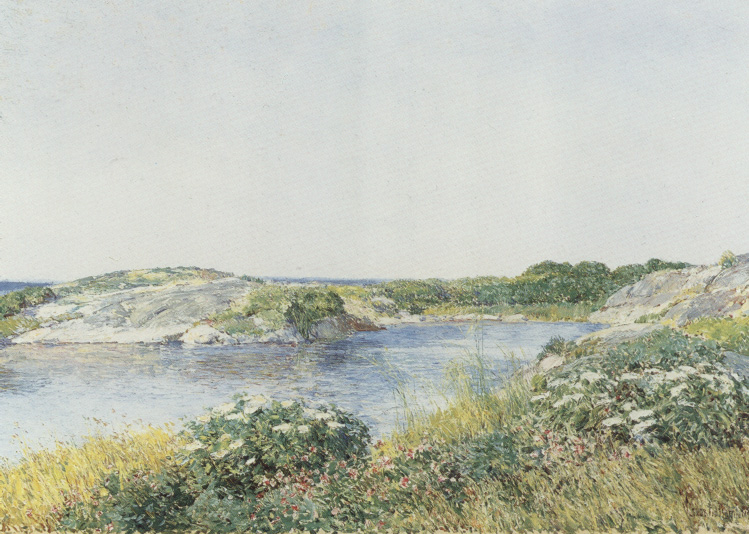 The Brown Decades, 1865-95
The Brown Decades, 1865-95
Childe Hassam, Pond at Appledore, 1890, Maine.
What is the meaning and value of landscape to a civilization?
Text | outline | ideas | 1880s | source | dates
"As a matter of fact, the importance of land increases with civilization: 'Nature' as a system of interests and activities is one of the chief creations of civilized man."
Written during the Great Depression, The Brown Decades by Lewis Mumford is a brief description of the conditions that altered the nation forever after the Civil War ended and before the Great Depression of 1892. Mumford as an architectural historian captured the mood of the country in seeking to rediscover an important legacy, lost in the collapse of financial markets, the destruction of farms and the staggering unemployment of one in four working people that lasted a decade.
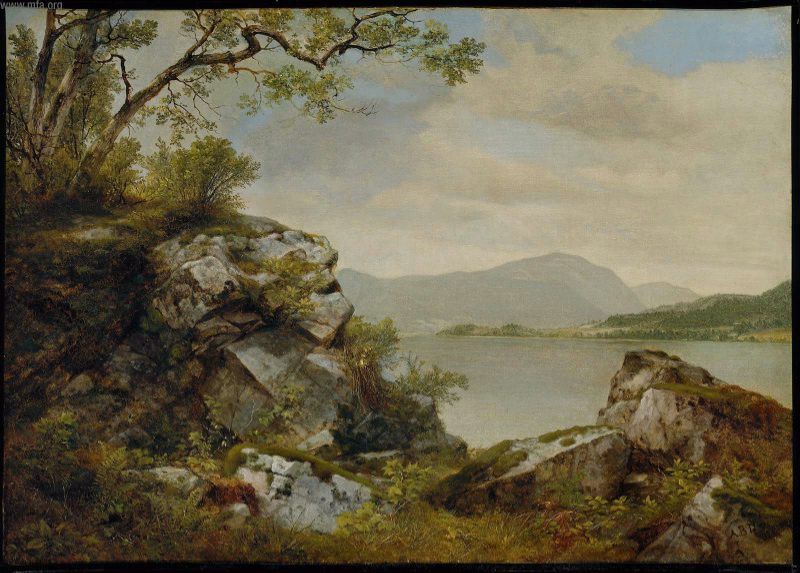 |
"Perhaps its most important service was to direct attention to a long-neglected scholar, George Perkins Marsh, and in particular to his classic, Man and Nature. Strangely, this work had been forgotten, even by American geographers, ...accompanied by a revaluation of ...Frederick Law Olmsted, since his handiwork as a town planner and landscape architect was visible from Stanford University and Golden Gate Park to Riverside, Illinois, and the Back Bay Fen way in Boston." While neither Marsh nor Olmsted was able to preserve the American landscape from spoilage and savage desecration, the guiding lines that they laid down for understanding and wisely using our natural resources are now belatedly being followed by awakened conservation and urban renewal groups in every part of the country." p. viii |
Asher B. Durand, "Lake George," 1860. Adirondacks, New York State. |
The Brown Decades, 1931. |
Olmsted | Boston common | Outline | Key ideas | his words | W.E.B. Dubois | Dates
![]() "The bridge, the garden, the ploughed field, the city are visible signs of men's relation are the visible signs of men's relation with the land; they are all means of ordering the earth and making it fit for for all varieties and modes of human habitation."
"The bridge, the garden, the ploughed field, the city are visible signs of men's relation are the visible signs of men's relation with the land; they are all means of ordering the earth and making it fit for for all varieties and modes of human habitation."
p. 26.
"There are occasional years when, after spring has leafed out and blossomed, a long series of storms and rains destroys one's sense of the summer."
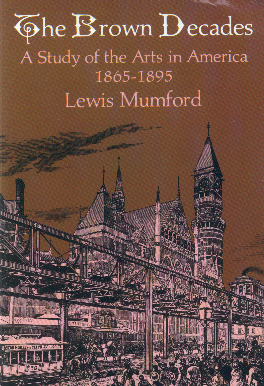 "The dilemmas, the hopes, the mistakes of the earlier period are so near to our own that it would be a wonder if we did not see its achievements clearly, too."
"The dilemmas, the hopes, the mistakes of the earlier period are so near to our own that it would be a wonder if we did not see its achievements clearly, too."
"Like our grandfathers, we face the aftermath of a war which has undermined Western Civilization as completely as the Civil War undermined the more hopeful institutions of our country."
But we need a fresh name for this period ...shall we call the years between 1865 and 1895 the Brown Decades [as] ... not inappropriate."
p. 1
"There was such a violent stormy summer, and such a sudden push of autumn, in the period of American history that began with the Civil War."
"THE CIVIL WAR SHOOK DOWN THE BLOSSOMS AND BLASTED THE PROMISE OF SPRING. "
"...the country looked different -- darker, sadder, soberer."
"The change was dramatically signaled by the death of Lincoln: it made the deep note of mourning universal, touching those who had stood outside the conflict"
"It is overwhelming, somber, sublime."
The mood... at bottom,...was not happy."
p. 2-3
Olmsted | Boston common | Outline | Key ideas | his words | W.E.B. Dubois | Dates
"By 1880 brown was the predominant note." 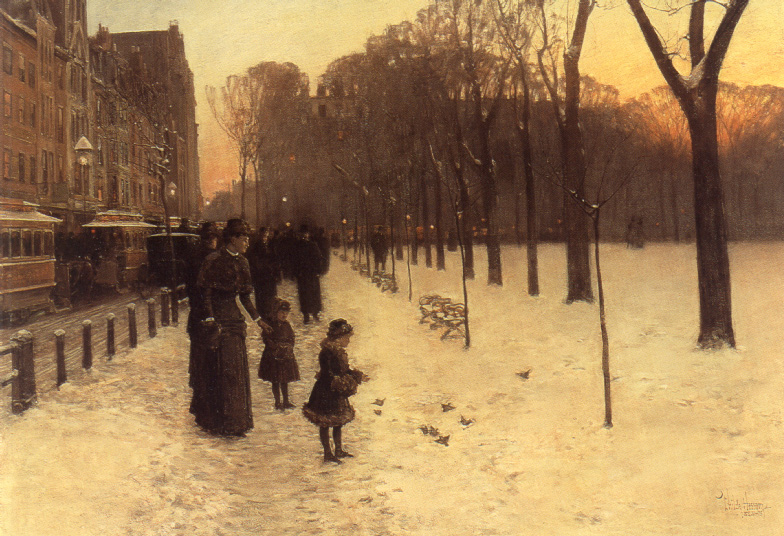
Childe Hassam, Boston Common, 1885.
Olmsted | Boston common | Outline | Key ideas | his words | W.E.B. Dubois | Dates
The seasonal changes in landscape provides a metaphor for historical changes in Mumford's essay.
The actual landscape is a document that can be understood, read if you will, by anyone willing to learn how to see in its elements, the features of the past.
Landscape is actually the creation of the human spirit in brick, and stone, trees and water together with those land elements and organic features inherent in geographical settings.
"the change that took place during the Brown Decades in our attitude toward the land."
"Henry George challenged the complacencies of bourgeois economics in terms the bourgeois economist could partly understand....From this point on, anyone who ignored the role of land in either American history or in our current institutional life was guilty of convenient forgetfulness the fact was established."
pp. 20-21.
Olmsted | Boston common | Outline | Key ideas | his words | W.E.B. Dubois | Dates
Outline
- "every generation revolts against its fathers..."
- Seasonal analogy to the post war period.
- A sudden absence of youth, characterized the post war era (they perished in the armies)
- "tragical recklessness" followed the expenditure of lives and treasure in he war.
- The pragmatism of William James, Psychology, and Charles Pierce (Son of a President).
- Transcendentalism was eclipsed by realism except for Emily Dickinson's poetry.
- "the emphasis o of the whole society shifted to the industrial and plastic arts."
- "is often an excuse for subservience to money, or a complete lack of intellectual integration."
- Henry George and "the change that took place in our attitude toward the land."
- America's "Buried Renaissance," under a "laval flow of industrialism" that had "swept over all the cities," ... "leaving here and there only an ashen ruin, standing erect in a crumbled landscape."
Muted character of the post war society:
"Riots, strikes, lockouts, assassinations, brutalities, exploitations marked the economic life of this period: at no period in American history had the working class...been more desperately enslaved."
p. 22
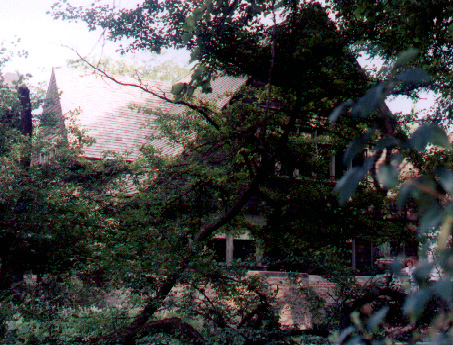
The shingle houses that Richardson first established on such sound lines ...brought an indigenous comeliness to the suburbs of the eighties and nothing...has touched so authentically the very colour and atmosphere of the landscape: incidentally they represent the peak of spaciousness and comfort in our domestic American facilities."
p. 23.
- 1838, Henry Hobson Richardson was born in Louisiana.
- 1864, Man and Nature, by George Perkins Marsh.
- 1865, Civil War ended and Lincoln was assassinated.
- 1868, John Wesley Powell's first descent of the Colorado River.
- 1871, Henry George criticizes the "squandering of the public domain," in US land policy.
- 1871, the Brooklyn Bridge begun & was completed to southeastern Manhattan in 1883.
- 1872, Credit Mobilier investment scandal and financial collapse.
- 1870s The Plains Indian wars and removal of Native American tribes to reservations.
- 1876, Philadelphia World's Centennial Exhibition.
- 1879, Progress and Poverty, written by Henry George, social critic of capitalism.
- 1880s "Modern architecture had its beginning in this period."
- 1881, Henry Hobson Richardson begins designing "Romanesque" railway stations.
- 1885, the New York State Constitution adopts the preservation of the Adirondack forests.
- 1888, Powell's irrigation survey identifies reclamation and reservoir sites in the west.
- 1890, census shows one in three people live in big cities & the solid frontier line had vanished.
- 1891, Forest Reserve Act allows for protection of western forests as watershed landscape.
- 1892, Chicago World's Columbian Exposition, White City, or "City of Light."
- 1893, the great depression unemployed families march on Washington D.C.
- 1898, Spanish American War and the invasion of Cuba, Puerto Rico, & the Philippines
The Adirondack Park Preserve was designated as "forever wild" on May 15, 1885.
Olmsted | Boston common | Outline | Key ideas | his words | W.E.B. Dubois | Dates
Frederick Law Olmsted's Boston regional park plan.
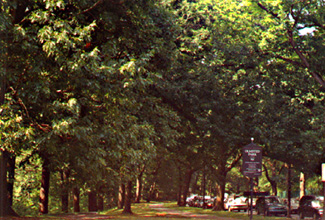
Frederick Law Olmsted's legacy weds wild nature and agrarianism to urban civilization:
“the enjoyment of scenery employs the mind without fatigue and yet exercises it; tranquilizes it and yet enlivens it; and thus through the influence of the mind over the body, gives the effect of refreshing rest and reinvigoration of the whole system.”
From 1863 he recognized that there was a need to slough off the tensions and cares of civilization, so Olmsted thought that California and the Yosemite Park Commissioners, had a “duty of preservation.”
Lewis Mumford (October 19, 1895 – January 26, 1990) was an American historian and philosopher of science and technology, and urbanization.
W. E. B. Dubois, The Black Belt, A description of rural, agrarian society, in south Georgia, 1890s.
W. E. B. Dubois, The Negro
Music
Charles Ives, a discordant note in an era of promise and decline.
Antonin Dvorak's 1892 arrival in NYC, The New World Symphony (1893)
Ragtime, work songs and spirituals.
Olmsted | Boston common | Outline | Key ideas | his words | W.E.B. Dubois | Dates
UPDATES: September 29, 2007, February 29, 2012, & July 7, 2014 .


